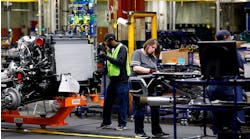The manufacturing jobs market is warming up again after tepid growth in December and January. According to the latest Employment Situation report from the Department of Labor, manufacturing employment increased last month by 36,000 new workers compared to the 16,000 new manufacturing workers in January. The overall private economy, meanwhile, saw 678,000 new jobs as the unemployment rate dipped to 3.8%.
The growth puts much of the employment economy within striking distance of pre-pandemic conditions. The Bureau of Labor Statistics, which produces the monthly report, noted that the unemployment rate in February 2020 was 3.5%, just 0.3% lower than it is now. Despite steady growth in the past year, though, manufacturing employment is still down by 1.4% compared to then.
Most of the growth in manufacturing employment was in durable goods industries despite losses in transportation equipment. Fabricated metal products manufacturers saw the most dramatic growth last month, adding 10,500 new workers. Gains there and in machinery, which took on 8,300 new employees, served to offset the 18,000 jobs lost in motor vehicles and parts manufacturing, which made up the bulk of the approximately 20,700 jobs lost in transportation equipment.
The remaining jobs gained in durable manufacturing were spread out: electrical equipment and appliances, miscellaneous durable goods, computer and electronic products, nonmetallic mineral products, and furniture all added at least 3,000 new jobs each.
Nondurable goods production added 16,000 new jobs, almost half in its largest section, food manufacturing. Food, beverage, and tobacco companies made up 7,200 of the jobs gained in nondurable manufacturing, followed by 4,300 in miscellaneous nondurable goods, 3,100 in paper and paper products, and 1,600 in petroleum and coal products. Estimated job losses were recorded in the chemicals (1,600 jobs) and printing sectors (about 200).
Manufacturing currently employs about 12.6 million people in the United States—approximately 12,607,000, according to the Bureau of Labor Statistics.




